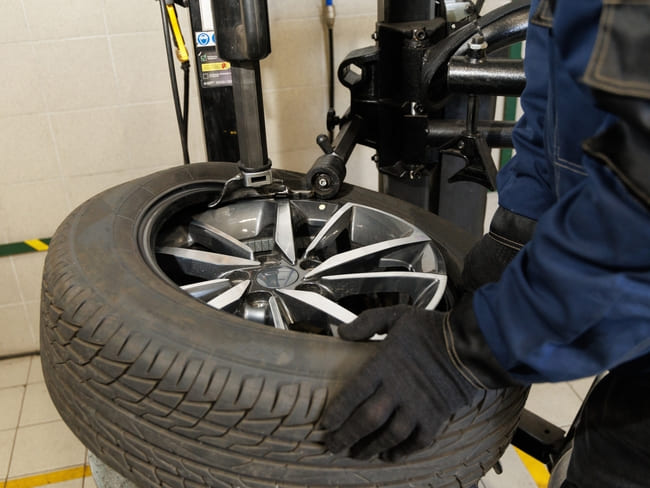Table of Contents
How to change a tyre: step-by-step guide, equipment, timing & costs in the UK
How to change a tyre: step-by-step guide
Changing a tyre doesn't have to be a daunting task. With the right tools and technique, you can swap out the wheel and get back on the road quickly and safely. This guide will walk you through the essential steps, from finding a safe spot to tightening the lug nuts properly. AUTODOC technicians recommend keeping these instructions handy in your glove compartment in case you get an expected flat. Here are the steps
Park safely and prepare
Pull completely off the road and onto a flat, stable surface away from traffic. Choose a straight stretch where approaching vehicles can see you from a distance. Avoid soft shoulders, inclines, and curves. Turn on your hazard lights to alert other drivers. Once you have stopped, select "Park" (for automatic vehicles) or first gear (for manual vehicles) and firmly engage the parking brake.
Gather tools
Before you begin, locate and assemble all the necessary equipment from your vehicle. You will need: a spare tyre, a jack, a wheel nut wrench, wheel chocks, the vehicle owner's manual for reference and gloves to protect your hands. Some vehicles also include special adapters for locking wheel nuts or hubcap removal tools. Place all tools on a visible surface, such as a floor mat, to avoid losing small parts.
Loosen the wheel nuts
Partially loosen the wheel nuts by turning them anticlockwise with the wheel nut wrench. Only loosen each nut by a quarter to a half turn; do not remove them completely yet. This step is much easier while the tyre is still on the ground, providing resistance. If the wheel has locking nuts, locate the special adapter key, usually stored with your spare tyre or in the glove compartment, and attach it to the wheel nut wrench.
Raise the car
Locate the designated jacking points near your flat tyre (check the manual if unsure). Place the jack securely on firm, level ground under the reinforced area. Slowly crank the jack until the tyre is about 15 cm off the ground – enough to remove and replace it. For safety reasons, never place any part of your body underneath the raised vehicle.
Take off the flat tyre
Fully unscrew all the nuts by hand and place them somewhere safe so they don’t roll away or get lost. Grip the tyre firmly with both hands and pull it straight toward you, using a gentle rocking motion if it's stuck. Place the flat tyre on its side away from your work area. Quickly check the wheel hub and wipe away any debris that might prevent the spare from mounting properly.

Fit the spare tyre
Lift the spare tyre and align its holes with the wheel studs on the hub. Gently push it onto the hub until it sits flush against the mounting surface. If it does not align perfectly, lower it and try again – never force it. Once positioned correctly, thread the nuts onto the studs by hand, turning them clockwise until finger-tight. Make sure they are evenly seated before lowering the vehicle.
Lower the car
Slowly lower the vehicle by releasing the jack's valve or reversing the cranking direction. Allow the spare tire to make contact with the ground first, then continue until the car's weight fully transfers off the jack. Remove the jack completely and verify the vehicle is sitting level with the spare properly seated before proceeding to the final tightening step.
Finish lowering and final checks
Fully lower the vehicle, check that all nuts are securely tightened, and stow the tools in a safe place.
With the car fully lowered, tighten all the wheel nuts in a star or cross pattern (never in a circle) using your full strength. This ensures even pressure distribution across the wheel. Check each nut twice to confirm it's secure. Stow all the tools in a safe place.
Drive carefully and have the tyre checked or replaced at a garage as soon as possible.
Sold by AUTODOC Sold by AUTODOC Sold by AUTODOC Sold by AUTODOC Sold by AUTODOC 

















What equipment do you need to change tyres?
To change a tyre, you'll need a spare tyre and a basic wheel-changing kit. Essential tools include a wheel brace (to loosen and tighten wheel nuts), a jack (to lift the car) and wheel chocks (to prevent rolling). A tyre removal tool, such as a pry bar, may also be useful. Many cars come with these items in a standard breakdown kit. If not, consider buying a compact kit for your car. Make sure your tools are in good condition and check the spare tyre regularly to ensure it is properly inflated.
Here’s a checklist:
- Spare tyre
- Wheel nut wrench
- Jack
- Wheel chocks
- Pry bar (optional)
When to change tyres
Tyres should be replaced every 3–5 years, even if they appear to be in good condition. Over time, rubber compounds degrade, reducing performance and safety regardless of use. This is especially true if your car is rarely driven, as tyres can age and crack while stationary. Check the date of manufacture stamped on the sidewall of your tyres to make sure they haven't exceeded their life expectancy. Also, monitor tread depth and replace tyres when they reach the legal minimum (1.6 mm in most areas). Regularly inspecting your tyres will help you spot wear, damage, or ageing early, preventing potential hazards.
How long does it take to change a tyre?
Replacing a single tyre typically takes 15–30 minutes, while changing two tyres can take slightly longer, depending on your experience and tools. Factors such as the type of vehicle, ease of access to the wheel nuts, and whether you're using a manual or hydraulic jack can all affect the time it takes. If you're less experienced or don't have the right equipment, the process could take longer. Make sure you have a complete, well-maintained tyre change kit to hand to speed things up. It’s also recommended to practice changing a tyre at home to build confidence and reduce the time needed in an emergency.
Can I replace just one tyre on my car?
You can change just one tyre, but it's important to consider the effect on your car's performance. A new tyre will have better tread and grip than the others, which could affect your car's balance and handling. For a safer, smoother ride, it's best to replace tyres in pairs to ensure equal performance on both sides of the axle. If you have to replace only one tyre, make sure it matches the size and type of your existing tyres. Keep an eye on your tyres regularly to spot wear early and keep you safe on the road.

Should you replace both front tyres at the same time?
Replacing both front tyres at the same time is ideal, especially if they're on the driven axle, as it ensures consistent performance and safety. Uneven tyre wear can affect handling, braking and stability, increasing the risk of accidents. On front-wheel-drive vehicles, mismatched tyres can stress the drivetrain or cause uneven performance, reducing comfort and durability.
If replacing both tyres isn't an option, make sure the new tyre matches the other in size, type, and tread pattern to avoid imbalance. This will help maintain control and harmony between the tyres in all conditions.
Can you change a tyre on the motorway?
Don't try to change a tyre on the motorway, even on the hard shoulder or in an emergency lane. Motorways are high-risk environments and stopping to change a tyre can put you in danger from oncoming traffic. Instead, stop safely, switch on your hazard lights and exit the vehicle on the side of the road away from traffic. Wait behind a barrier if possible and call for professional assistance. Prioritising safety over a quick fix will ensure your well-being and minimise the risk to other road users.
How much does it cost to change a tyre in the UK?
The cost of changing a tyre in the UK varies greatly depending on the size, brand and type of tyre. Smaller, low-end tyres can be expected to cost between £45 and £70 each, as they use less material and have lower speed and load ratings. Mid-range tyres typically cost between £80 and £150, while high-end or performance tyres can cost between £220 and £1,200 per tyre.
Additional costs may include fitting, balancing, and disposal fees, which often add £10–£25 per tyre. Mobile tyre fitting services may charge extra for convenience. To save money, compare prices from local garages and online retailers and make sure the tyre meets your vehicle's specifications and safety standards.
Sold by AUTODOC Sold by AUTODOC Sold by AUTODOC Sold by AUTODOC Sold by AUTODOC 


















Where to get my tyres changed near me?
If you're looking for a local tyre fitter, there are plenty of options to suit your needs. From local garages and national chains to mobile fitting services, finding a reliable supplier has never been easier. Many services allow you to book online, compare prices, and even opt for same-day fitting at your home or workplace. Whether you need a quick change or a full set of tyres, make sure the service provider is reputable and uses quality products. Always prioritise safety by choosing trusted professionals who can keep you on the road with minimal fuss.
FAQs
How long does it take to change a tyre?
With practice, it should take you about 15–30 minutes. First-timers might need 45 minutes or more. It's better to work methodically than to rush, as proper installation ensures your safety.
Do I need special tools to change a tyre?
You will need a jack, a wheel nut wrench and a spare tyre, all of which are typically included with your vehicle. Some vehicles require a special key for anti-theft nuts. A torch, gloves and wheel chocks are also useful.
Is it safe to change a tyre on the side of a busy road?
If possible, pull completely off the road onto a flat, stable surface. Turn on your hazard lights and set up reflective triangles. Work on the side of the vehicle away from traffic. If the location feels unsafe, call for roadside assistance instead.
How can I tell if my spare tyre is in good condition?
Check the air pressure in your spare regularly (monthly is ideal). Inspect it for cracks, bulges or excessive wear. Most temporary spares have a maximum speed rating of 50 mph and should only be used to drive a short distance to get a new tyre fitted.
A useful video on this topic:
What kind of tyres should I choose for my car? How do I choose tyres myself?
Top products related to this topic:




































